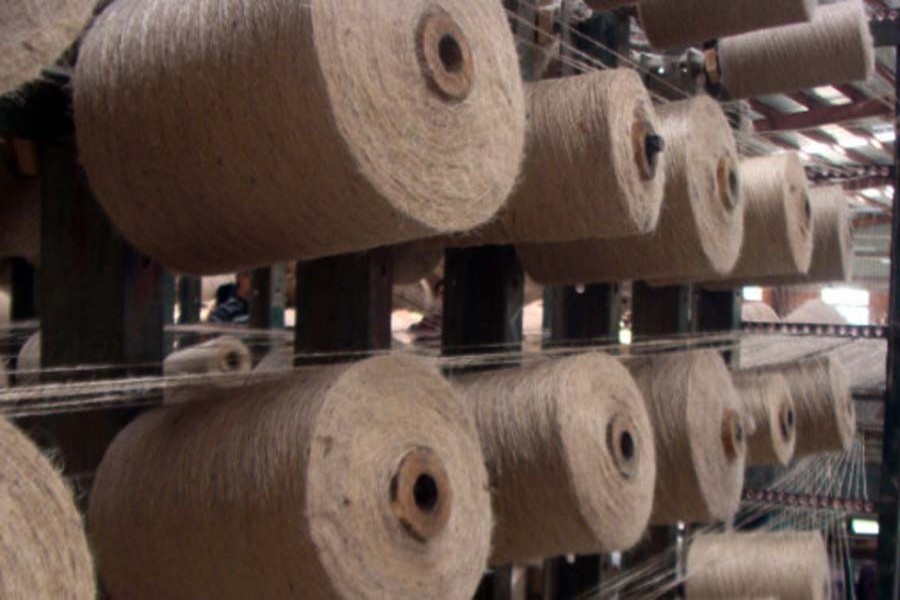Before independence, jute was the chief cash crop of the country and it accounted for more than 50 per cent of the export earning. Being the biggest foreign-exchange earner, jute also figured prominently in the pre-independence political discourse of this region. Unsurprisingly, jute was called 'Golden Fibre,' and rightly so. As such, it was natural to expect that jute would get its due place in the country's economy after independence. But things did not turn out that way. The state-run jute mills that employed a large number of workers could not make profit. Corruption and labour strikes, clashes, often bloody, among rival workers' unions were mostly to blame for the jute sector's gradual decline.
The jute growers, on the other hand, could not get their labour's worth when they brought raw jute to the market for sale. It had and still has to do with the dominance of the middlemen, or farias, on the raw-jute market. Even so, it was the raw jute that continued to hold Bangladesh's image as the producer of 'Golden Fibre' in the international market. All the credit for it, however, goes to the country's jute farmers who never failed the country as the growers of the world's best-quality jute. But if they only get a raw deal as a reward for their hard labour, how long could they continue cultivating the crop sustainably? But, despite these issues, Bangladesh still dominates the international market with its 40 per cent share of global jute export and controls 30 per cent of the yarn market as the world's biggest jute-yarn producer. But then why is jute far behind, for instance, the garments, leather and leather products and such other items, when it comes to Bangladesh's earning from exports?
In fact, jute gradually gave way to its synthetic alternatives which were cheaper and more durable. As a result, traditional jute products like gunny bags, jute twines, hessian cloth, carpet backings faced hard competition in the international market. The synthetic yarn and other similar plastic products proved to be cheaper and more durable. Entrepreneurs also did not come in a big way to prop up jute through properly branding jute and jute-based products in the international market. Meanwhile, garments and a few other items stole a march on jute and are now the country's major foreign currency earners through exports.
Luckily, the global outlook for jute has been changing as the harmful sides of synthetic, especially, plastic, products have started to become evident to the environment-conscious people. Since jute is a natural product, its appeal as a wrapping material is also increasing. According to a study, shopping bags made of jute are in high demand in the international market (about 500 billion pieces annually). And the market for other jute-based products is also growing by leaps and bounds. Bangladesh as the producer of the best quality jute in the world should be able to claim its rightful share of this market. But at the same time, one has to keep in mind that Bangladesh has also its competitors like India, China, Brazil and Uzbekistan in the global markets. They are not only growers of jute, most of these countries possess advanced technologies as well as business acumen to grab sizeable portions of this ever-expanding jute market. So, it is high time that the government treated jute with the highest priority and provided the entrepreneurs in this sector the kind of incentives that other export earners like the readymade garment (RMG) have been enjoying. And promoting jute is also necessary if only to diversify the country's narrow export basket. Admittedly, jute has its especial advantage on this score. Unlike RMG, the jute industry will not have to depend for its raw material on external sources. What is more, jute will not need any extra effort to promote it in the international market. What would be vital to enable jute to reclaim its past glory is developing the interest of the private sector entrepreneurs. In fact, potential of jute at the moment is immense. Over the past years, the export earnings from jute have been increasing significantly. According to the Export Promotion Bureau (EPB), jute and jute-based products earned US$1.1 billion in FY 2020-21 from exports. The figure is 30 per cent higher than what it was in the previous fiscal. Such a positive trend in jute export has been sustained over the past few years.
Interestingly, the FY 21's rise in export earnings from jute has taken place even though the volume of jute produced in the country in FY 21 dropped by three hundred thousand bales compared to the previous fiscal at 8.0 billion bales. The reason behind this development is obviously better harvest of the cash crop in the major jute growing districts of Bangladesh. The success has largely to do with both the growers' hard work and the better, high-yielding variety of jute seeds they have used.
Notably, the true potential of jute is yet to be fully explored and exploited. Apart from making packaging and binding materials, decorative objects and the like, the jute leaves are also used as food. The story of jute is long and old. It has to be retold with a narrative that fits well with the modern times.
The British colonialists introduced the jute from Bengal to the Western world in the late eighteenth century. Jute mills of Dundee in Scotland made cordage for ship's rigging. Gradually, from the mid-19th century jute mills began to be established in Kolkata, the then-capital of British India. But, by the third quarter of the last century, jute began to lose its shine. Mercifully, jute has again caught global attention. Bangladesh must claim its niche in the burgeoning global jute market.


